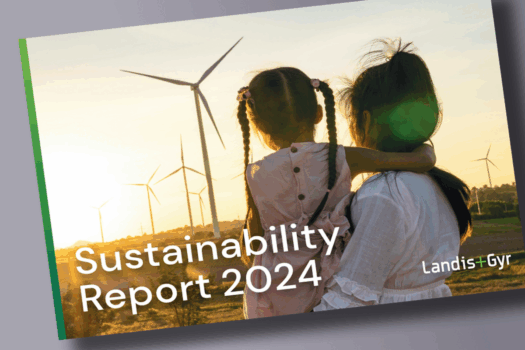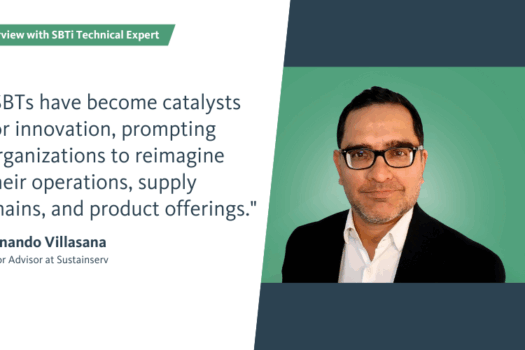As a consultant in the field of sustainability, Stephan Lienin has advised companies about everything from strategy development to integrated reporting for nearly 20 years. He’s seen it all during this time, from short-lived hypes to genuine trends and disruptive developments. However, he and his colleagues at Sustainserv are currently mulling over the industry buzzword “online first.” Lienin, who holds a doctorate in natural sciences and is a passionate amateur actor, talks about the new challenges facing the not-so-new internet in a conversation with Thomas Gromann.
You are more likely to find Stephan Lienin in the executive offices of corporations and organizations than in the offices of Sustainserv in Zurich or Boston. It’s too bad, because the view from the stunning old building directly above the Central public square in Zurich offers a wonderful view of the venerable main station across the Limmat river — that is, for everyone except Stephan Lienin, whose office window is just a stone’s throw away from Zurich’s Polybahn funicular railway.

Thomas Gromann: Stephan Lienin, your offices couldn’t be any more “Zurich,” could they?
Stephan Lienin: No, they really couldn’t. We’re located right in the heart of the city, and the Polybahn is its pulse. Rail cars go by every couple minutes. But, unfortunately, I’m not here all that often.
Where and how do you spend most of your time?
Usually with customers in Switzerland and Germany and sometimes in other parts of the world. I started Sustainserv in 2001 with two partners and we now have 15 employees, both here and in Boston. Our customers, who work in more than 20 different industries, are scattered all over, so we also work on a global scale.
And how about in your private life?
I like to stay local. I spend whatever little free time I have with my family, or doing street photography and improv theater.
We’ve worked together for a while now and, of course, I googled you right away. But it wasn’t as easy to find your work as an actor among the mountains of other publications and professional articles.
True. That’s because we are pretty niche. We do it just for fun and it’s also pretty odd.
Albisufeine Theater!
The other guys in our troupe earn money through theater. I actually did professional theater training, but my career now takes place on a different stage, usually one with PowerPoints and flip charts.
Back to business now. As an agency, we deal with the concrete design and implementation of annual reports, sustainability reports and integrated reports. However, as a consultant at Sustainserv, you deal mostly with strategies, structures and hard facts.
The overlap between our work as a consultancy and communication agencies can be quite varied. We often just supply the content for a layout, but it gets more exciting when we get to collaborate at the conceptional level to optimize form and content.
As an agency, we are always amazed by how the internet is still considered new and completely trendy in the world of annual reports. Today, speakers at industry conferences still refer to “online first” with reverence as the next big thing, even in 2019.
Right. It’s really a challenge in that world.
There are usually a couple hundred well-educated professionals from corporate communications, investor relations and controlling in the audience, most of whom are in the upper ranks. They all check their smartphone every 15 minutes, read the news online and have used apps for years. Yet “the internet” is still uncharted territory for them. Do you find it astonishing and also a tad funny?
That might be a little arrogant. Publishing annual reports online is actually a big challenge for many companies. We have helped several companies do it and most of our clients are in the process of ramping up for it. It’s actually not as trivial as it might seem to an outsider.
What is so different between online reports and printed reports?
Historically, the whole process comes from print and finance. Simply put, annual financial statements were produced in the past by a printing company. A couple pictures were then added, and maybe a few stories, too.
However, an integrated online report imposes very different requirements, and financials are just one aspect. Non-financials are actually almost just as important. It’s about demonstrating the value created by a particular enterprise both in and of itself and for society. And how it creates it, and especially how it wants to create it in the future, and how it will protect it.
An approach in integrated reporting that includes the concept of the six forms of capital established by IR.
That’s an important approach. You can use the six forms of capital to illustrate value creation as a whole. Plus, there is currently a trend towards demonstrating a company’s long-term impact on economic, social and ecological development. The 17 Sustainable Development Goals (SDGs) of the United Nations is a good example. They are all incorporated into the concept of reporting and change the requirements placed on an integrated report quite a bit.
And it brings the traditional printed report to its limit.
Well-made online publications can show those kinds of complex relationships and information better than a printed report. Financials and non-financials can be connected and illustrated much better. All you really need for financials is a few charts, graphics and explanations. Non-financials, on the other hand, can be documented quite differently. You can use videos, stories, photo galleries and interactive tools.
We regularly look at the reports in the rankings for annual reporting. The majority put a more or less interactive version of the printed PDF online. In the worst case scenario, it still contains crop and print marks.
As I mentioned, the industry operated this way for decades. Even I sometimes struggle to think about it differently. It’s a learning process. The “mother document,” meaning the complete printed version, is often still the starting point and serves as the basis for building a website.
You mean more like “throw together” than “build”?
Well, I also have to disagree with you a bit here. There are some really excellent online reports out there.
Like the one by Clariant?
Our client Clariant actually won the award for best annual reporting for its integrated report in 2017. Their report combines print and online reporting as well as financials and non-financials in a tightly woven and exciting way.
Let’s talk about potential. What does a company stand to gain by venturing into the realm of “online first”?
Usually, multiple objectives are pursued in parallel. For example, integrated reporting, online reporting, new certifications and so on. These areas of change afford incredible opportunities. We are usually tapped to help with this process. From structuring and articulating business models to targeted positioning, strategy development and reporting, our experts run the gamut. Online or even “online first” offer the opportunity to give more or equal weight to non-financials and to sharpen and further develop the business model.
Why the business model?
Because it is often forgotten that it is actually at the core. And also because visually illustrating the business model is an important aspect of integrated reporting. It’s best to make it interactive and animated. Then agencies step in and ask what exactly needs to be visualized and how to do it. That’s often the impetus for starting to think about it.
It’s true that we often get a jumble of PowerPoint slides and are asked to make a nice graphic for the online annual report. As soon as we look at things more closely, we realize that there are either many different versions of the business model or that it is no longer current.
Discussions of the business model usually begin with questions about representation. How the company creates value and the easiest way to depict it should be the central question.
We usually begin our communication projects with a simple question: who is the target audience and what kind of goals do you want to achieve in terms of knowledge, attitude and behavior? When it’s about annual reports, their immediate response is analysts and shareholders. Then, after a short pause, a bunch of stakeholders are mentioned, usually in a vague and confused way, and the communication goals are usually not clearly articulated.
The first couple of target groups are usually relatively clear. Analysts should evaluate the company highly and ideally recommend it…
…and the shareholders should trust the board of directors and management, approve their salaries and bonuses and basically leave them to their own devices.
I think that’s too narrow and simplistic. We see cases where the report is used for employer branding and offers a real leg up in the war for recruiting talent, or it contributes to achieving company-wide sustainability goals.
In these cases, the online version is particularly important. Few if any applicants will order a printed version in order to form an impression of a company.
The high potentials will really scrutinize a potential employer. And they usually do it online on their smartphones. If there’s only a printed PDF or the site is slow…
…then they also form a certain impression.
But maybe the wrong one. Maybe the company is actually very modern and innovative, but the annual report and sustainability report is a decade behind because the process and structure are not up to date.
Our analysis of online behavior shows that the majority of site visitors go directly to the numbers. That’s probably the analysts. We’ve compared it in the past to hunting for Easter eggs. We take the numbers that the analysts want to find and spread them across a lot of pages throughout the entire report. The analysts then print out the report, hunt for the numbers, highlight them and enter them into their Excel spreadsheets. It’s pretty much like hiding Easter eggs before the hunt begins. It’s pure folklore.
I know what you mean (chuckles). An online report can also be useful here. For some clients, we’ve created a download that is now restricted to a certain number of analysts in the sustainability field, both as a formatted PDF and a CSV file. Analysts can then download it and import it into their Excel spreadsheets, but they still need the report to verify the numbers and content. So, it’s not entirely folklore!
Some companies also find stopgaps. For example, they have a relatively condensed online report with all the important numbers from across the company, which simultaneously helps with branding through intense storytelling using images, video and text. The report for the auditors, agencies and analysts is then delivered as an interactive PDF optimized for laptops and tablets. Analysts can then also easily print it out for themselves in the office if they want. There is no need to produce a version for offset printing, which is complicated. In our opinion, this is a pragmatic solution, but it’s only a stopgap. What do you think of that?
I think it’s great. Especially because it’s better to do things step by step every year than to want to do everything in one giant step. That’s usually not the best solution, not even in terms of finance.
What is the best solution, in your experience?
It depends on the time frame. If someone asks us in November for a report for the following March, we will, of course, go for the low-hanging fruit first. If they have more time and want to test out various approaches, then a mock-up report can be quite useful. It provides the structure and form of the report without needing to first obtain real data, a process that is often painstaking, if not impossible. This means that an optimal report can be prepared with all internal, or even external, stakeholders. The process can take a few months or last one to two years.
Is the additional effort worthwhile?
Yes, especially if you have to convince various internal stakeholders. But first, the insights should be incorporated into concurrent reports and statistics whenever possible. Plus, you also avoid shortcuts. When you consider it over two or three years, you save not only money, but also time. Apart from that, this kind of approach delivers convincing results, both internally and externally.
And, last but not least: is “online first” the future of reporting?
Forecasts about the future are always difficult. But in this case, I would definitely say yes!
Thanks for the conversation, Stephan!
Published in therefore
Get in touch. We are happy to tell you more about it.





